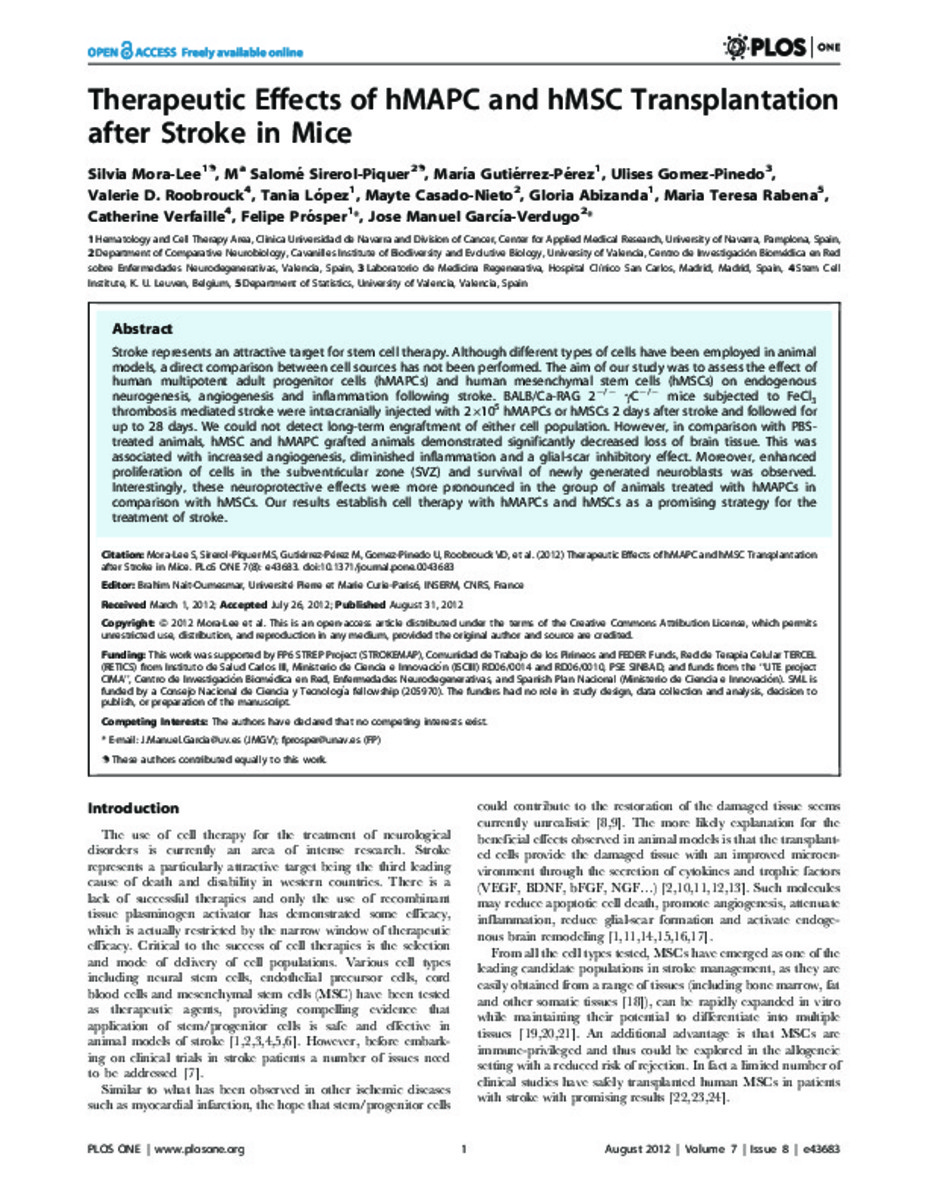Full metadata record
| DC Field | Value | Language |
|---|---|---|
| dc.creator | Mora-Lee, S. (Silvia) | - |
| dc.creator | Sirerol-Piquer, M.S. (María Salomé) | - |
| dc.creator | Gutierres-Perez, M. (M.) | - |
| dc.creator | Gomez-Pinedo, U. (Ulises) | - |
| dc.creator | Roobrouck, V.D. (V. D.) | - |
| dc.creator | Lopez, T. (Tania) | - |
| dc.creator | Casado-Nieto, M. (Maite) | - |
| dc.creator | Abizanda-Sarasa, G. (Gloria) | - |
| dc.creator | Rabena, M.T. (M. T.) | - |
| dc.creator | Verfaillie, C.M. (Catherine M.) | - |
| dc.creator | Prosper-Cardoso, F. (Felipe) | - |
| dc.creator | Garcia-Verdugo, J.M. (José Manuel) | - |
| dc.date.accessioned | 2014-02-27T14:58:45Z | - |
| dc.date.available | 2014-02-27T14:58:45Z | - |
| dc.date.issued | 2012 | - |
| dc.identifier.citation | Mora-Lee S, Sirerol-Piquer MS, Gutiérrez-Pérez M, Gomez-Pinedo U, Roobrouck VD, López T et al. Therapeutic effects of hMAPC and hMSC transplantation after stroke in mice.PLoS One. 2012;7(8):e43683. | es_ES |
| dc.identifier.issn | 1932-6203 | - |
| dc.identifier.uri | https://hdl.handle.net/10171/35316 | - |
| dc.description.abstract | Stroke represents an attractive target for stem cell therapy. Although different types of cells have been employed in animal models, a direct comparison between cell sources has not been performed. The aim of our study was to assess the effect of human multipotent adult progenitor cells (hMAPCs) and human mesenchymal stem cells (hMSCs) on endogenous neurogenesis, angiogenesis and inflammation following stroke. BALB/Ca-RAG 2(-/-) γC(-/-) mice subjected to FeCl(3) thrombosis mediated stroke were intracranially injected with 2 × 10(5) hMAPCs or hMSCs 2 days after stroke and followed for up to 28 days. We could not detect long-term engraftment of either cell population. However, in comparison with PBS-treated animals, hMSC and hMAPC grafted animals demonstrated significantly decreased loss of brain tissue. This was associated with increased angiogenesis, diminished inflammation and a glial-scar inhibitory effect. Moreover, enhanced proliferation of cells in the subventricular zone (SVZ) and survival of newly generated neuroblasts was observed. Interestingly, these neuroprotective effects were more pronounced in the group of animals treated with hMAPCs in comparison with hMSCs. Our results establish cell therapy with hMAPCs and hMSCs as a promising strategy for the treatment of stroke | es_ES |
| dc.language.iso | eng | es_ES |
| dc.publisher | Public Library of Science | es_ES |
| dc.rights | info:eu-repo/semantics/openAccess | es_ES |
| dc.rights | info:eu-repo/semantics/openAccess | es_ES |
| dc.subject | hMAPC and hMSC | es_ES |
| dc.subject | Transplantation | es_ES |
| dc.subject | Therapeutic effects | es_ES |
| dc.title | Therapeutic effects of hMAPC and hMSC transplantation after stroke in mice | es_ES |
| dc.type | info:eu-repo/semantics/article | es_ES |
Files in This Item:
Statistics and impact
Items in Dadun are protected by copyright, with all rights reserved, unless otherwise indicated.






